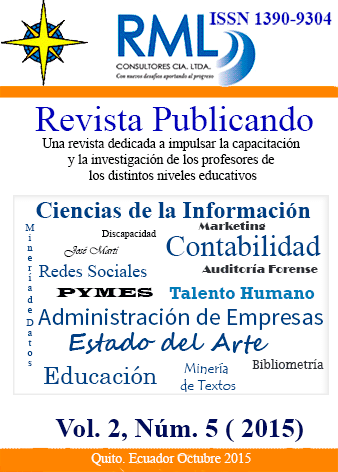Resumen
RESUMEN
Se realizó una revisión bibliográfica en ScienceDirect para los términos “Data Mining” AND “fraud” lo que permitió seleccionar un total de 86 artículos para el periodo 2000 al 2015. Esta revisión comprobó que aplicación de las técnicas de la Minería de Datos para la detección de los distintos tipos de fraude contable es una tendencia de investigación actual que puede ser de gran utilidad. La Minería de Datos permite realizar los procesos de clasificación, detección de valores anómalos., agrupamiento, predicción y regresión, todos necesarios para poder tratar los datos contables.
Se aplicó RapidMiner para poder ejemplificar la detección de valores anómalos y el agrupamiento por clústeres de una data de prueba seleccionada de 1000 datos. Las posibilidades de visualización existentes permiten a la vez una fácil detección, tanto de los posibles valores anómalos como del posible agrupamiento de los datos.
La investigación realizada sugiere la combinación de las posibilidades de la Minería de Datos en el análisis de un mayor volumen de datos y a la vez la introducción de estas técnicas en la docencia actual de la Contabilidad.
ABSTRACT
A literature review on ScienceDirect for the terms "Data Mining" AND "fraud" allowed selecting 86 papers for the period 2000 to 2015. This review allowed finding that the application of data mining techniques is useful to detect the different types of accounting frauds. In addition, is also a current research topic Data mining allows developing the processes of: classification, detection of outliers, clustering, forecasting and regression, all necessary to treat the accounting data
RapidMiner was applied to illustrate the detection of outliers and clustering of the selected test data. The existing visualization possibilities allow also and easy detection of outliers and the clustering of data.
The research suggests a combination of the possibilities of data mining in the analysis of a greater volume of data and the introduction of these techniques in the current teaching of Accounting.
Referencias
Agrawal, S., & Agrawal, J. (2015). Survey on Anomaly Detection using Data Mining Techniques. Procedia Computer Science, 60, 708-713. doi: http://dx.doi.org/10.1016/j.procs.2015.08.220
Belfo, F., & Trigo, A. (2013). Accounting Information Systems: Tradition and Future Directions. Procedia Technology, 9, 536-546. doi: http://dx.doi.org/10.1016/j.protcy.2013.12.060
Bolton, R. J., & Hand, D. J. (2002). Statistical fraud detection: A review. Statistical science, 235-249.
Chen, H., Chiang, R. H., & Storey, V. C. (2012). Business Intelligence and Analytics: From Big Data to Big Impact. MIS quarterly, 36(4), 1165-1188.
González-Alonso, J. A., Fabian-Pazmiño, J., & Pérez-González, Y. (2015). Posicionamiento en Google Académico y en la WEB de la Revista Ciencias Holguín. Ciencias Holguín, 21(2), 44-54.
Ngai, E. W., Xiu, L., & Chau, D. C. (2009). Application of data mining techniques in customer relationship management: A literature review and classification. Expert Systems with Applications, 36(2), 2592-2602.
Phua, C., Lee, V., Smith, K., & Gayler, R. (2010). A comprehensive survey of data mining-based fraud detection research. arXiv preprint arXiv:1009.6119.
RapidMiner. (2014). Products. RapidMiner Studio. Retrieved 8 Enero, 2014, from http://rapidminer.com/products/rapidminer-studio/
ScienceDirect. (2015). ScienceDirect. Retrieved Junio, 2015, from http://www.sciencedirect.com/
Sharma, A., & Panigrahi, P. K. (2013). A review of financial accounting fraud detection based on data mining techniques. arXiv preprint arXiv:1309.3944.
Software, D. (2015). Data Mining Techniques. Statistics – Textbook. Retrieved Agosto 15, 2015, from http://documents.software.dell.com/Statistics/Textbook/Data-Mining-Techniques#mining
Thornton, D., Brinkhuis, M., Amrit, C., & Aly, R. (2015). Categorizing and Describing the Types of Fraud in Healthcare. Procedia Computer Science, 64, 713-720. doi: http://dx.doi.org/10.1016/j.procs.2015.08.594
Trigo, A., Belfo, F., & Estébanez, R. P. (2014). Accounting Information Systems: The Challenge of the Real-time Reporting. Procedia Technology, 16, 118-127. doi: http://dx.doi.org/10.1016/j.protcy.2014.10.075
Zareapoor, M., & Shamsolmoali, P. (2015). Application of Credit Card Fraud Detection: Based on Bagging Ensemble Classifier. Procedia Computer Science, 48, 679-685. doi: http://dx.doi.org/10.1016/j.procs.2015.04.201
Zengin, K., Esgi, N., Erginer, E., & Aksoy, M. E. (2011). A sample study on applying data mining research techniques in educational science: Developing a more meaning of data. Procedia - Social and Behavioral Sciences, 15, 4028-4032. doi: http://dx.doi.org/10.1016/j.sbspro.2011.04.408
Zhou, Z.-H. (2003). Three perspectives of data mining. Artificial Intelligence, 143(1), 139-146. doi: http://dx.doi.org/10.1016/S0004-3702(02)00357-0
Usted es libre de:
Compartir — copiar y redistribuir el material en cualquier medio o formato
Adaptar — remezclar, transformar y construir a partir del material
La licenciante no puede revocar estas libertades en tanto usted siga los términos de la licencia
Bajo los siguientes términos:
Atribución — Usted debe dar crédito de manera adecuada, brindar un enlace a la licencia, e indicar si se han realizado cambios. Puede hacerlo en cualquier forma razonable, pero no de forma tal que sugiera que usted o su uso tienen el apoyo de la licenciante.
NoComercial — Usted no puede hacer uso del material con propósitos comerciales.
CompartirIgual — Si remezcla, transforma o crea a partir del material, debe distribuir su contribución bajo la lamisma licencia del original.
